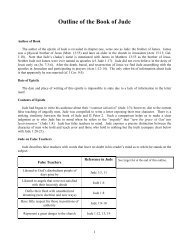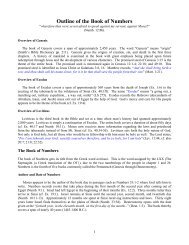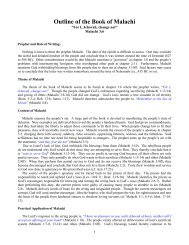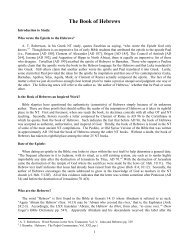Outline of the Book of I Timothy - The Floral Heights Church of Christ
Outline of the Book of I Timothy - The Floral Heights Church of Christ
Outline of the Book of I Timothy - The Floral Heights Church of Christ
Create successful ePaper yourself
Turn your PDF publications into a flip-book with our unique Google optimized e-Paper software.
D. Leaving <strong>the</strong> area <strong>of</strong> Macedonia, Paul travels to Nicopolis where he had planned to spend <strong>the</strong> winter (Titus<br />
3:12). “<strong>The</strong> city at which Paul instructed Titus to meet him (Tit. 3:12) was most likely Nicopolis in Epirus,<br />
sometimes ra<strong>the</strong>r generally referred to as Nicopolis in Achaia.” 1<br />
E. Paul writes <strong>the</strong> first epistle to <strong>Timothy</strong> from Nicopolis (65 AD) (I Tim. 1:3).<br />
F. Paul sends Artemas or Tychicus to relieve Titus in Crete (Titus 3:12).<br />
G. Having heard <strong>of</strong> <strong>the</strong> troubles in Crete, Paul traveled back to <strong>the</strong> island with Titus, Erastus and Trophimus (II<br />
Tim. 4:20) before going to Rome. Crete had a city named Miletus, as did Asia.<br />
H. It is likely that Paul hears <strong>of</strong> <strong>the</strong> atrocities occurring in Rome against <strong>the</strong> <strong>Christ</strong>ians and decides to travel <strong>the</strong>re<br />
to encourage <strong>the</strong> brethren (65 AD).<br />
I. Arriving at Rome, Paul is in immediate danger <strong>of</strong> being captured and persecuted. Rome was in a state <strong>of</strong><br />
upheaval. <strong>Christ</strong>ians were being unmercifully persecuted. “<strong>The</strong> Emperor Nero having set fire to <strong>the</strong> city on <strong>the</strong><br />
10 th <strong>of</strong> July, AD 64, to remove <strong>the</strong> odium <strong>of</strong> that nefarious action, which was generally imputed to him, he<br />
endeavored to make <strong>the</strong> public believe it was perpetrated by <strong>the</strong> <strong>Christ</strong>ians, who, at that time, were become <strong>the</strong><br />
objects <strong>of</strong> <strong>the</strong> popular hatred, on account <strong>of</strong> <strong>the</strong>ir religion. For, as if <strong>the</strong>y had been <strong>the</strong> incendiaries, he caused<br />
<strong>the</strong>m to be sought out, and put to death in <strong>the</strong> most barbarous manner.” 2<br />
J. Paul is soon imprisoned at Rome for a second time as a malefactor (II Tim. 2:9) (65 AD). A “malefactor” is a<br />
“criminal, vile; one doing harm, hurtful” (LS 394). This indicates a different imprisonment than <strong>the</strong> one<br />
mentioned by Luke in Acts 28. Luke describes Paul’s imprisonment at that time (AD 63) as a pleasant one.<br />
Paul was allowed to dwell in peace and preach <strong>the</strong> gospel message to all who would hear (Acts 28:30-31 [see<br />
also Phil. 2:19-24]).<br />
K. While imprisoned in Rome for <strong>the</strong> second time, he makes a defense before <strong>the</strong> Roman council (II Tim. 4:16). It<br />
appears that <strong>the</strong> second epistle to <strong>Timothy</strong> was written after this defense. <strong>Timothy</strong> has remained in Ephesus <strong>the</strong><br />
entire time (II Tim. 4:9-12 as compared with Titus 3:12 and 4:19).<br />
L. Paul’s life ends in Rome.<br />
1<br />
Borchert, G. L. <strong>The</strong> International Standard Bible Encyclopedia; Vol. 3, pg. 534<br />
2<br />
MacKnight, J. MacKnight on <strong>the</strong> Epistles. A New Literal Translation from <strong>the</strong> Original Greek, <strong>of</strong> all <strong>the</strong> Apostolical<br />
Epistles; Vol. III – IV pg. 282.<br />
3








